The England national side has suddenly come into a lot of depth at the right-back slot. Manager Gareth Southgate has a number of options at his disposal, which is a far cry from the situation as recently as a couple of seasons ago. While Keiran Trippier and Kyle Walker were the two right-backs who made the trip to the 2018 World Cup in Russia, both of them are over 30 years of age now, with Walker not having been in the England set-up since the beginning of the season. Trippier is still trusted by Southgate after his performances at that tournament, and his move to Atletico Madrid in the summer has improved the defensive side of his game. Nevertheless, there are some excellent young prospects coming through in the Premier League, and it is not fanciful to think that England could go to next year’s Euros with neither of these two players as part of the squad. The likes of Aaron Wan-Bissaka, Trent Alexander-Arnold, and Reece James could all be England’s right-back for the next decade or so, which shows just how competitive a spot this has become.
This data analysis will look at the numbers for all the English right-backs across Europe’s top five leagues, to arrive at the best possible choice for Southgate to pick in his starting XI.
Setting the scene
A few points before we dive into the data. I have considered all English players who have played at right-back this season across the top five European leagues, with Trippier and Jonjoe Kenny being the only players to be included from outside the Premier League. Secondly, a player must have had at least 900 minutes of action this season, which has removed Kyle Walker-Peters and James Justin from the longlist for this analysis. Finally, while the aim is to try and identify which of the main contenders for the right-back slot is better suited for England, I will highlight other players who do well on our metrics as well. All data has been taken from Wyscout.
Defensive ability
While the role of the modern full-back has evolved to an extent where they provide a lot of the attacking impetus for a number of sides, there is still a need for them to be defensively sound in order to be able to succeed at the top level. At international level, it can be argued that a well-drilled defence can take a team much further than it would at club level, which then makes it even more important for the defensive players to be competent. England, under Southgate, have tried to transition to a possession-focused style of play, after being largely reactive at the World Cup, and thus there is a greater risk for the side to be hit on the counter-attack, especially against weaker opposition. Therefore, there is a need for the players to be extremely proficient at winning the ball back and stopping dangerous counter-attacks.
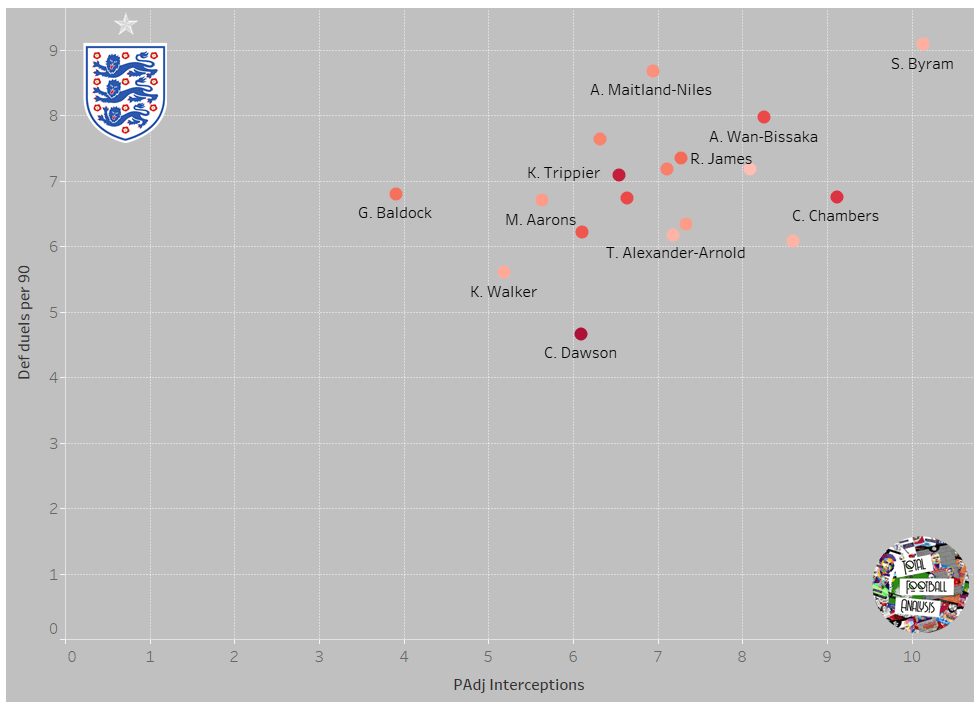
Our first chart looks at defensive duels/90 and possession-adjusted (PAdj) interceptions, along with the success rate for defensive duels. For the uninitiated, PAdj statistics allow for better comparisons between players from different teams, as they are ‘adjusted’ so that the inherent bias in defensive statistics where teams which have less of the ball will invariably rack up higher defensive numbers is removed. Also, in this chart, the deeper the shade of red, the higher that player’s defensive duel success rate.
We can see that Norwich City’s Sam Byram, a player who is a right-back but has actually played more at left-back for the Canaries this season, leads all the players for defensive duels/90 and PAdj interceptions. However, his success rate is not the best, as he only wins 53.9% of his duels to be fourth-bottom on that metric. Of our main contenders, Keiran Trippier and Aaron Wan-Bissaka win 70% and 64% of their duels respectively, while Kyle Walker and Trent Alexander-Arnold are towards the bottom of the list with 54.5% and 53.5% win rates respectively. Chelsea’s Reece James does well here, with a 61% win rate, as well as ranking well on the other two defensive metrics.
It is interesting to note that along with his low duel win rate, Walker also has the second-lowest numbers for both PAdj interceptions and defensive duels/90. While this is a reflection of Manchester City’s playing style of dominating possession, it is still a worrying picture for the 30-year-old. Alexander-Arnold, on the other hand, has the fourth-lowest defensive duels/90 but does decently well for interceptions, which is perhaps an indication of Liverpool’s tendency to press aggressively for long periods of the game. Wan-Bissaka has 7.97 defensive duels/90, the third-highest of this group, and he is also fourth for PAdj interceptions, underlying his defensive quality.
From a purely defensive point-of-view, it would seem that Wan-Bissaka is the best option for Southgate, with the Manchester United full-back doing better than his immediate challengers on all three metrics. Reece James makes a decent case as well, and we can expect to see him get better as he gains more experience in the league. Alexander-Arnold, while being lauded for his creative abilities, is not as proficient defensively, which may be an issue for England at major tournaments when they come up against stronger opponents. Trippier is a strong candidate as well, having improved that side of this game under Diego Simeone at Atletico, while Walker’s poor performance is perhaps an indicator that his best days are behind him, certainly with regard to his defensive ability. Interestingly, the chart shows that Arsenal’s Ainsley Maitland-Niles could be an option, as he ranks high for both metrics, with a 57.2% duel success rate. While the youngster sees himself as a midfielder, he has done well this season at right-back, although it remains to be seen if he is played in that position in the future.
Crossing
One of England’s most potent weapons at the 2018 World Cup was Trippier’s crossing ability from the right. Time and again the then-Spurs defender would send in crosses towards the likes of Harry Kane from deeper positions on the pitch, allowing England to get the ball up the field quickly when they regained possession, as well as providing a significant attacking threat. This is one of the major components of Southgate’s style of play, especially with Kane leading the line, as he has the aerial presence to be able to win duels. The Premier League season has also demonstrated how effective this can be as an attacking weapon, with Alexander-Arnold and Andrew Robertson racking up the assists from their full-back positions for Liverpool and constantly switching the play from one flank to the other.
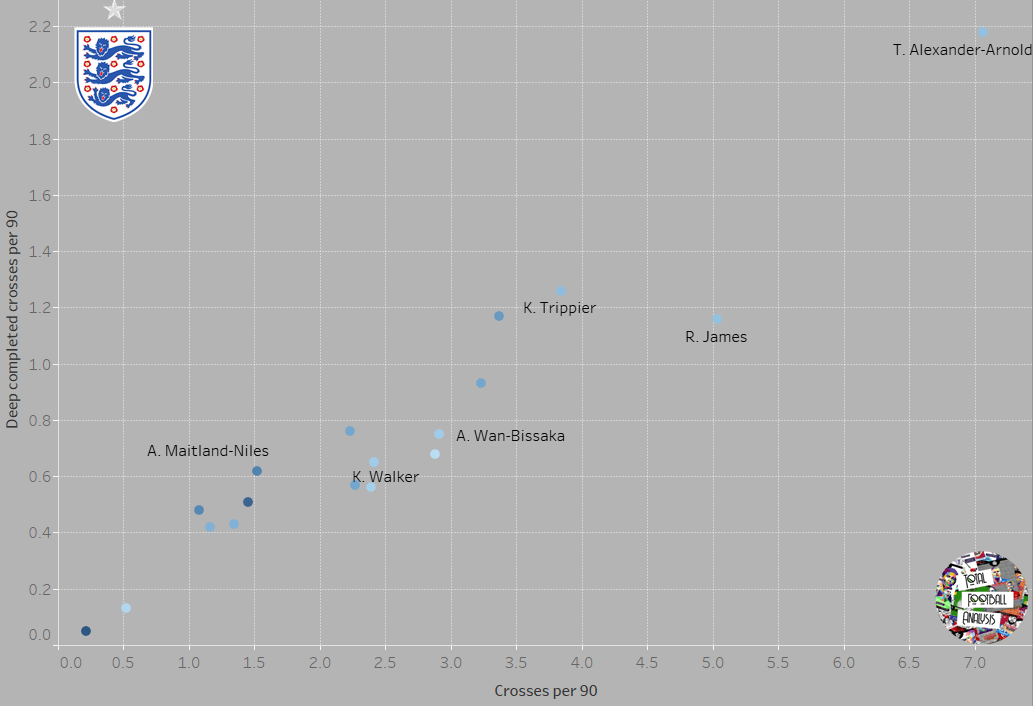
This chart looks at crosses/90 and deep completed crosses/90, while the shade of blue depicts the success rate for crosses, with a deeper shade meaning a higher success rate. It is not surprising to see that Alexander-Arnold attempts the most crosses of any player on our list, with 7.06 crosses/90, as well as the most deep completed crosses with 2.18/90. However, his success rate is just under 30%. Now, to put this into context, cross success rates of over 30% are considered extremely good, so the fact that the Liverpool full-back is hitting this as well as providing as many as seven crosses per 90 minutes makes him an exceptionally good crosser of the ball. Most of the players on this chart with success rates over 30% rank very low for the number of crosses and deep crosses, which further illustrates just how good Alexander-Arnold has been at this aspect of his game.
Of the main contenders, it is clear that Wan-Bissaka needs to work on this side of his game, with just under 3 crosses and 0.75 deep completed crosses/90. However, his success rate of 27.2% is not too shabby, and he had shown improvements in this side of the game in the last few matches before the Premier League was suspended. Trippier and James are both decently proficient at sending crosses in as well, with success rates of 30% and 29.2% respectively. However, Walker once again fares as the worst of the most obvious contenders, with a success rate of 26.9% for his 2.4 crosses/90, and with 0.65 deep completed crosses/90.
This chart makes it clear that Alexander-Arnold is the best crosser of these players by far, potentially one of the best in the world, and this ability could be extremely useful for England as a way to break down teams.
Creativity
Full-backs have been increasingly tasked with the creative burdens for their sides over the last decade or so, as the general trend in football tactics has seen the centre of the pitch get increasingly crowded, with most of the space out wide. Teams like Liverpool rely a lot on their full-backs to progress the ball forwards, while they are often also used to provide width and stretch the play. This is the case with England as well, especially with the likes of Raheem Sterling and Marcus Rashford on the flanks, who will look to come inside and thus create space for the full-backs on the overlap.
Thus, we will look at some charts which show these players’ creativity and their ability to fashion high-quality chances for their teammates.
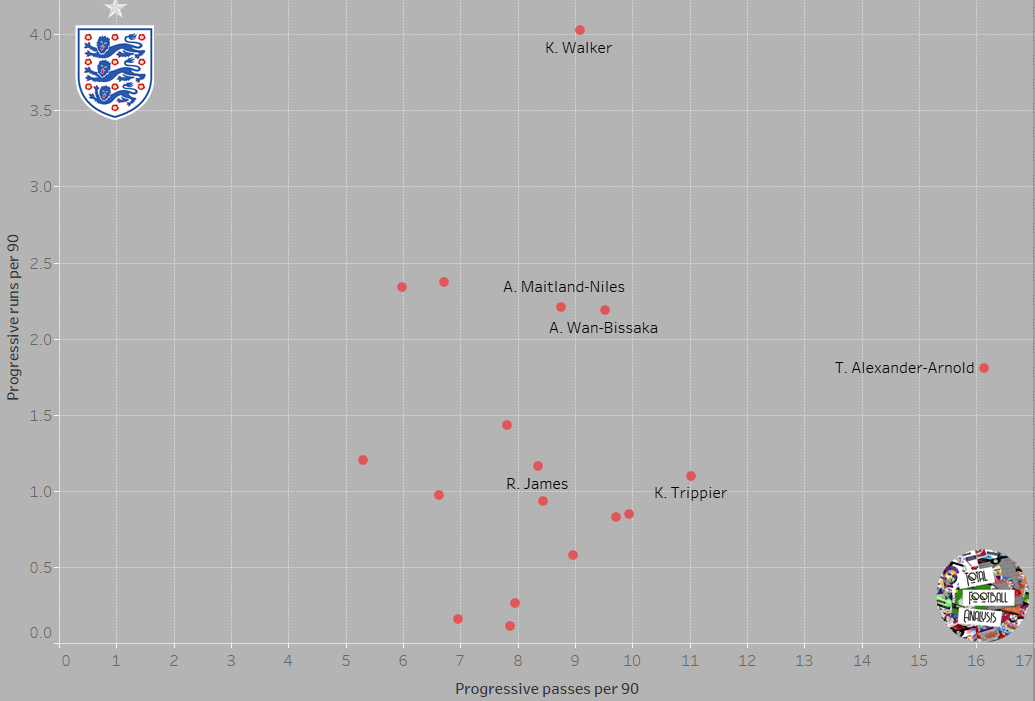
Our first chart in this section looks at progressive passes and progressive runs/90 minutes. Both of these measures are good ways to understand a player’s ability to move the ball up the pitch, either through passes or by running with the ball itself. Alexander-Arnold comes out as the clear leader for progressive passes/90, with a staggering 16.13 such passes, with Trippier the only other player to get into double figures for this measure, notching 11.03 passes/90. On the other end of the scale, Walker makes 4.03 progressive runs/90, dwarfing his main competitors. Aaron Wan-Bissaka is positioned somewhere in the middle for these measures, with 9.52 progressive passes and 2.19 progressive runs/90, while Reece James is significantly lower on the chart.
These conclusions pass the eye test as well, as anybody who has seen Liverpool play this season will attest to Alexander-Arnold’s quality on the ball, while Walker is known more for his energy and preference to get up the pitch with the ball rather than any great passing ability. Once again, Wan-Bissaka displays a good blend of the two skills, while James’ numbers show that he has the potential to get better.
Another extremely important part of the modern full-back’s armoury is dribbling. This attribute is essential to allow players to get past defensively-minded opponents and create space for themselves or for their teammates. With the amount of time spent by full-backs in the final third of the pitch, it is important that they can beat their opponent in a 1v1.
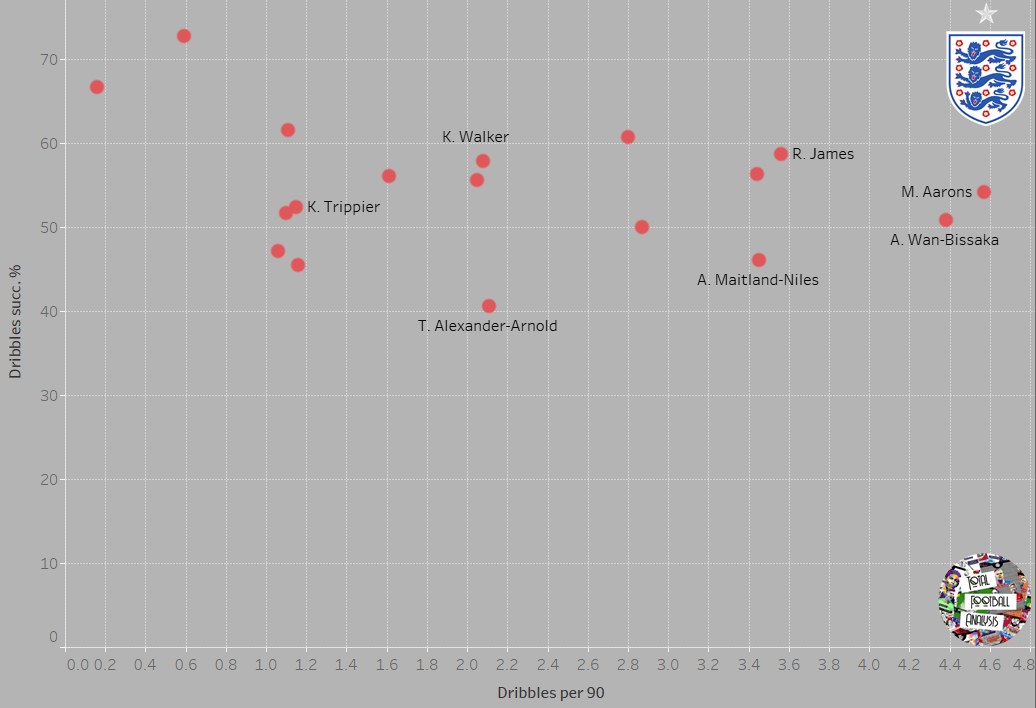
This chart plots dribbles/90 and the success rate for dribbles for our candidates, and it is immediately evident that most of them have success rates around 50%, with the higher outliers not attempting a significant number of dribbles/90.
Max Aarons of Norwich City attempts the most dribbles, with 4.57/90, and does so with a decent success rate of 54.2%. Of our main contenders, Wan-Bissaka, James and Maitland-Niles are all quite proficient at dribbling as the chart shows, while this may be one of the weaknesses in Alexander-Arnold’s game, as he attempts just 2.1 dribbles/90, with a 40.6% success rate. Walker and Trippier both have higher success rates, but Trippier makes only 1.15 dribbles/90 minutes.
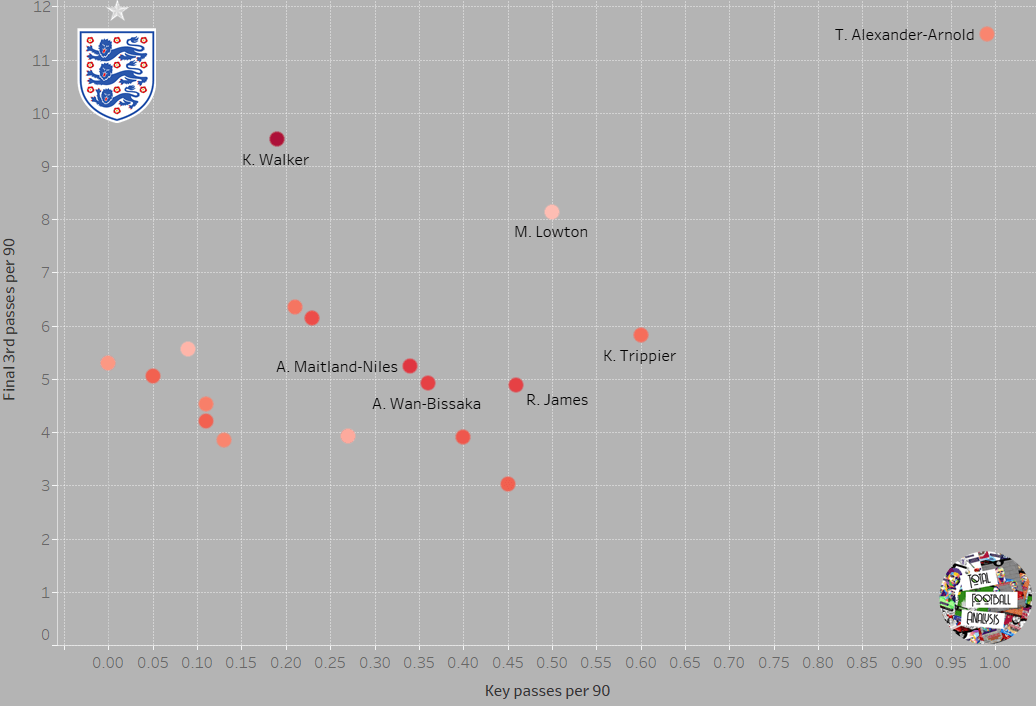
The ability to affect the game in the final third is another important part of a full-back’s job description in football today, and so this chart looks at our candidates’ key passes/90 and final third passes per 90, while the shade of red indicates their success rate for final third passes, with the deeper shades indicating higher success rates.
Once again, it is Alexander-Arnold who comes out head and shoulders above his peers on these metrics, notching 0.99 key passes/90 and 11.5 final third passes/90, with a 58.3% accuracy rate. However, Walker is very good at passing to teammates in attacking areas as well, with 9.5 such passes per 90 minutes, and the highest accuracy of the group with 84.9%. He is also second on the list of key passes per 90, but at 0.19 such passes, trails Alexander-Arnold by a huge number.
This is the case for all of our candidates, as Alexander-Arnold’s key pass numbers are unmatched. The likes of Trippier, James and Wan-Bissaka are all decently placed in terms of final 3rd passes as well as accuracy rates, but cannot compete with the Liverpool full-back for key passes.
Conclusion
So, after this extensive data analysis, we can definitely say that Trent Alexander-Arnold is by far the most creative option at right-back, with the ability to make high-quality chances for his teammates, as well as affect the game in the final third through his passing and crossing. He does need to improve on the defensive side of his game though, and that is something that England will need to keep in mind when selecting him in their squad. Kyle Walker is still a very good right-back, but his numbers suggest that there are potentially better and younger options available for Southgate to look at. Aaron Wan-Bissaka is extremely proficient defensively, while he is also improving on the attacking metrics, and so is definitely one to watch, as he could soon have the perfect blend of defensive and attacking talent to be one of the best right-backs in the country, while Reece James also has a lot of potential, but an England call-up is perhaps a little too soon at the moment, with another season of top-flight action needed to give him more experience and the chance to get better at both sides of the game. Finally, Trippier does have the ability to still contribute, but as with Walker, it is possible that Southgate is now looking towards the younger alternatives.
Thus, our conclusion is that Alexander-Arnold would be the best fit for England’s style of play, with Wan-Bissaka providing a very good option as backup, with the potential to take up a starting place if he can improve his offensive metrics.





Comments